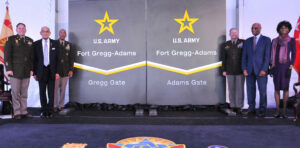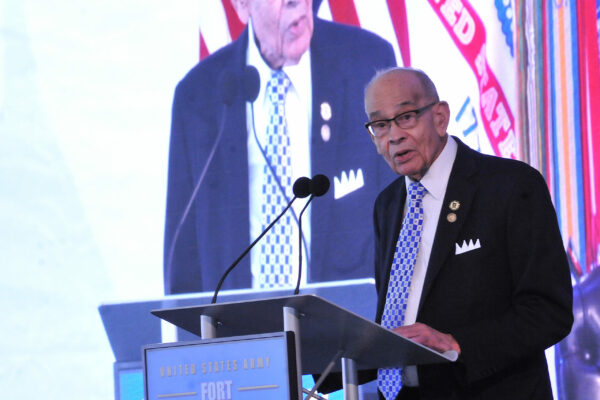Terrance Bell | Fort Gregg-Adams Public Affairs Office | April 27, 2023
FORT GREGG-ADAMS, Va. — The Army installation formerly known as Fort Lee became Fort Gregg-Adams during a historic redesignation ceremony — held at the Gregg-Adams Club — April 27, becoming the first Army installation named for Black military members.
The new name honors retired Lt. Gen. Arthur J. Gregg and the late Lt. Col. Charity Adams. Gregg is the Army’s first Black three-star general and namesake of an Army logistics award.
Adams – as she was known before leaving military service and taking the married name Earley – led the 6888th Central Postal Directory Battalion beyond mission accomplishment in the European Theater of Operations during World War II.
Maj. Gen. Mark T. Simerly, CASCOM and Fort Gregg-Adams commanding general and senior commander, was host for the ceremony. During opening statements, he said the honorees collectively represent those willing to sacrifice in defense of the nation.
“The service of Lt. Gen. Gregg and Lt. Col. Adams reflect the courage and character of the millions of men and women who have worn this uniform and defended this nation,” he said. “This historic day belongs to American Soldiers – past, present and future.”
Later in his speech, he said the two officers shared commonalities that were critical to their growth as individuals and Soldiers.
“Today, we recognize Arthur Gregg and Charity Adams for their courage, dignity and their hope,” he said. “Despite growing up in a segregated nation, these two pioneers volunteered to serve that nation in uniform. Their service, both in war and peace, demonstrate the courage is not confined to a single race or gender.”
Fort Gregg-Adams is one of nine Army installations being redesignated. The redesignations are the result of congressional legislation requiring the removal of Confederate names from Department of Defense assets, which includes nine Army posts.
A crowd of more than 1,000 people viewed the ceremony from a tent erected on the club’s front lawn. Several hundred more watched from remote viewing sites across the installation. The ceremony also was livestreamed to a global audience.
Gen. Charles R. Hamilton, commanding general, Army Materiel Command, joined Simerly and Gregg on stage as did Col. James Hoyman, commander, U.S. Army Garrison; and Stanley Earley III and Ms. Judith Earley, the adult children of Stanley Earley Jr. and the late Lt. Col. Charity Adams.
Others who attended the ceremony included Guy Kiyokawa, acting deputy, Department of Veteran Affairs; members of the Naming Commission; and countless numbers of military members, veterans and elected officials and local leaders.

During his address, Hamilton captured the sentiment of many in the crowd.
“Well, as most of you can imagine, I’m standing here humbled and swollen with a lot of pride for Gen. Gregg and Lt. Col. Adams,” he said.
Paying tribute to those who have sacrificed serves more than one purpose, he added.
“We honor and commemorate legends for their achievement,” said Hamilton. “By doing so, we preserve their legacy and ensure their contributions are remembered for generations to come and to provide an example of inspiration. Also, to show them how they can even do and achieve more. That’s why we take great care in naming installations. It’s a great opportunity to make a difference.”
Gregg’s career has made a difference. The Army’s first African American three-star general and the only one among the redesignation namesakes still living, he was the event’s most anticipated speaker. The 94-year-old took the podium to a standing ovation, one of several during the ceremony. He thanked his family and all who supported his career, and said he hoped the name change can serve as inspiration.
“I hope that this community will look with pride on the name ‘Fort Gregg-Adams,’ and that the name will instill pride in every Soldier entering our mighty gates.”
A week earlier, Gregg was present at the same facility for the rechristening of the former Lee Club. The club was still reserved exclusively for white officers after he was commissioned and started serving here in 1950.
A South Carolina native who spent part of his childhood in Newport News, Virginia, Gregg enlisted in the Army as a private in 1946. The institution was still segregated, and he was not spared from its ugliness. Segregation persisted when he became an officer three years later. The Army became fully integrated in 1954.
Among the highlights of Gregg’s career was a tour in Vietnam with the 96th Quartermaster Direct Support Battalion. It was fraught with difficulty because the unit failed to meet certain preparation requirements, but Gregg and his staff worked diligently to overcome the slow start.
In the theater of operations, the 96th QDSB grew to include 3,700 troops – one of the largest battalions in country – and operated a major logistics base. It earned a unit citation for its performance, and Gregg was sent to the Army War College.
He earned his first star in 1972 and his second in 1976. Upon pinning on his third star in 1977, he was selected by the president to be the director of logistics for the Joint Chiefs of Staff. His last assignment was chief, Office of the Deputy Chief of staff for Logistics, Department of the Army.
Adams, a Columbia, S.C., native and graduate of Wilberforce University, joined the Women’s Auxiliary Army Corps (later the Women’s Army Corps) in 1942. She attended officer candidate school at Fort Des Moines, Iowa, becoming the first Black woman in the WAC to earn a commission.
In late 1944, Adams received orders for a mission in Europe. She found out while travelling over the Atlantic she would be commanding a predominately Black, all-female postal battalion charged with clearing several hangars full of backlogged mail.
The unit, nicknamed the Six Triple Eight, faced various challenges while stationed in England and France. This included racism among American troops, cultural differences with local populations, logistical problems and numerous other issues.
The unit was given a six-month deadline to complete a mission where others had failed. It completed the job in half the time.
In all, the Six Triple Eight processed 17 million pieces of mail in less than a year. As a result of the unit’s success, Adams was promoted to lieutenant colonel, making her the highest ranked Black woman in the Army at only 27 years of age.
Adams resigned her commissioned in 1946 and spent the rest of her life in service to humanity. Her endeavors included sitting on the boards of numerous public and private entities and volunteering with the YWCA, National Urban League and United Way.
Additionally, Adams was the founder of the Black Leadership Development Group and co-founder of Parity, a local equity and diversity advocacy group.
She died in 2002.
Stanley Earley III and his sister, Judith, did not speak during the ceremony. During a media roundtable discussion, however, Stanley III said the event was extremely moving and allowed him to reflect on his mother’s accomplishments.
“It was breathtaking,” he said.
The redesignation work will continue after the ceremony. In addition to the name changes for the installation and club, the base is required to change numerous street signs, a continuing effort that is to be completed by the end of the year.
Fort Gregg-Adams was established in 1917 as Camp Lee. It accommodated thousands of troops in preparation for World War I.
Following the war, it closed and became under jurisdiction of the state. Camp Lee reopened in 1941 to support WWII, again training thousands of troops. It became permanent in 1950.
Today, Fort Gregg-Adams trains more than 70,000 military members and civilians annually as the home to CASCOM and the Sustainment Center of Excellence.
Related News:

